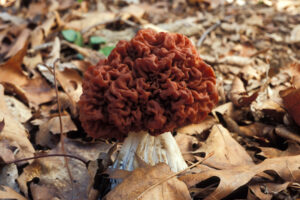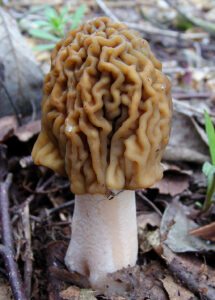Morel Hunting 101
Springtime in Idaho and across the Northwest brings mushroom lovers into our forests for a time-honored activity – hunting mushrooms! Below is some basic information to help you learn more about hunting mushrooms, but this is not intended to serve as a formal field guide.One of the most important things to know is that you should never eat a mushroom that you can't positively identify. Morels (Morchella spp.), which are widespread across North America and much of the globe, are one of the most prized delicacies in mushroom hunting. Morels have a distinctive honeycombed cap with ridges and pits. The stem and the cap are continuous and appear to grow into each other.And they're delicious!Although morels have a distinct look, some species can be confused, so make sure you know for sure before you cook and eat any mushroom! Some people can also be allergic to morels, so start with cooking and eating a small amount to make sure you do not have a reaction. ALL MORELS MUST BE COOKED before eating. Morchella Elata, a common black morel found in Idaho, has also been reported to result in reactions when consumed with alcohol – so be cautious with anything else you might be consuming at the same time.Where to look: Morels can be found across Idaho but are most common in coniferous forests in the spring and early summer. In the year following a forest fire, morels can be sometimes be found in abundance. They can be found along streams and ponds, in open areas, dense forests, brushy areas, along trails, and everywhere in between. When you find one, stop and look closely for others – they can often be found in groups or “seams.”When to look: May and early-mid June are primetime for morel hunting across Idaho, and through July-August in North Idaho. In fact, you can find morels into August and September at higher elevations, if the conditions are right. Warm weather after spring/early summer rains can provide optimal conditions. As temperatures warm, head for higher elevations.How to harvest: As a rule, only pick morels that are larger than your thumb. Leave some mushrooms behind to mature (and for others to find…I know this is hard)! Slicing mushrooms with a pocketknife helps protect the sensitive roots (mycelia) and keeps your mushrooms cleaner. Pick only morels that are in good condition – mushy, crumbly, morels won’t hold up. Gather your mushrooms in a basket or cloth bag, (don’t use plastic bags, morels need to breathe). Leave at least 20% of the mushrooms you find in the woods.Permit rules: In most areas, the Forest Service offers free personal use permits that allow for collecting up to 5 gallons of mushrooms per day. Burned areas can be closed for safety, to protect resources, or because of other uses (i.e. salvage logging and tree-felling). Some personal use permits from the Forest Service require you to slice the morels in half (lengthwise) to prevent them from being sold commercially. Check in with the land managers or landowners for more info, as local regulations can vary, especially in the year following big fires.How to prepare or store: Morels can keep up to about a week in a well ventilated bag in the fridge. The best option if you're not going to eat them fresh is to dehydrate them, and you can store them for years. To prepare, I soak morels in salted water for 15 minutes and then rinse and pat dry. Slice morels lengthwise to cook evenly. Some also recommend simply brushing off dirt and debris (and not soaking or running under water). Then sauté morels in butter, garlic and salt. You can also bread and fry your mushrooms, or stuff and bake them. As long as you cook them, you can’t really go wrong!What mushrooms can be confused with morels: The two most common types of mushrooms that can be confused with morels are False Morels (Verpa spp.) or Brain Morels (Gyromitra spp.).Snow or Brain Morel (Gyromitra esculenta) Gyromitra species often have a "wrinkled" or "cerebral" (brain-like) appearance to the cap due to multiple wrinkles and folds, rather than the honeycomb appearance of true morels due to ridges and pits. False Morel (Verpa bohemica)
Gyromitra species often have a "wrinkled" or "cerebral" (brain-like) appearance to the cap due to multiple wrinkles and folds, rather than the honeycomb appearance of true morels due to ridges and pits. False Morel (Verpa bohemica) The caps of Verpa species are attached to the stem only at the apex (top of the cap), unlike true morels which have caps that are attached to the stem at, or near, the base of the cap. Other mushrooms that can be harvested: Many other mushrooms can be found in Idaho, some of which are considered edible. These include chantrelle (Cantharellus spp.), coral (Ramaria spp.), bolete (Boletus spp.) and many other species of mushrooms. In general, as you head north in Idaho, more species can be found.Key considerations: Recently burned areas can be dangerous with hazard trees, burned root holes, loose rocks, unstable slopes and more. Always remember to use caution, avoid burned areas during windstorms, tell others where you’ll be, watch for ticks, and don’t hike alone. A GPS unit is a great investment, as it’s easy to get turned around when following ridges and draws while hunting mushrooms. Anytime you travel in the forest, be prepared with a map, water, emergency blanket, food, and warm clothing.For More Info:1) Mushrooms Demystified, by David Arora2) Southern Idaho Mycological Association (idahomushroomclub.org)3) www.TheGreatMorel.comIf you want more guides and information to plan your next Idaho adventure sent directly to you, or to stay updated on Idaho's public lands and how to do your part to protect them – sign up for ICL’s public lands emails.
The caps of Verpa species are attached to the stem only at the apex (top of the cap), unlike true morels which have caps that are attached to the stem at, or near, the base of the cap. Other mushrooms that can be harvested: Many other mushrooms can be found in Idaho, some of which are considered edible. These include chantrelle (Cantharellus spp.), coral (Ramaria spp.), bolete (Boletus spp.) and many other species of mushrooms. In general, as you head north in Idaho, more species can be found.Key considerations: Recently burned areas can be dangerous with hazard trees, burned root holes, loose rocks, unstable slopes and more. Always remember to use caution, avoid burned areas during windstorms, tell others where you’ll be, watch for ticks, and don’t hike alone. A GPS unit is a great investment, as it’s easy to get turned around when following ridges and draws while hunting mushrooms. Anytime you travel in the forest, be prepared with a map, water, emergency blanket, food, and warm clothing.For More Info:1) Mushrooms Demystified, by David Arora2) Southern Idaho Mycological Association (idahomushroomclub.org)3) www.TheGreatMorel.comIf you want more guides and information to plan your next Idaho adventure sent directly to you, or to stay updated on Idaho's public lands and how to do your part to protect them – sign up for ICL’s public lands emails.

